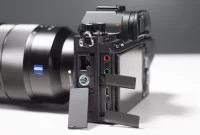Are you a photography enthusiast looking to take your skills to the next level? In this article, we will delve deep into the world of advanced features that make certain cameras stand out from the rest. Get ready to explore the unique capabilities that can take your photography experience to new heights.
Understanding the Importance of Image Stabilization
Image stabilization is a crucial feature found in modern cameras, offering photographers and videographers the ability to capture crisp and clear images even in challenging shooting conditions. This advanced technology compensates for camera shake and minimizes blur, resulting in sharper and more professional-looking photos and videos.
One of the main reasons why image stabilization is so important is its ability to reduce the impact of hand movements during handheld shooting. Even the steadiest of hands can introduce slight shake, especially when shooting with longer focal lengths or slower shutter speeds. Image stabilization compensates for these movements, allowing photographers to capture sharper images without the need for a tripod or other stabilization tools.
Furthermore, image stabilization also enhances the performance of cameras in low-light situations. When shooting in dimly lit environments, the camera often needs to use slower shutter speeds to achieve proper exposure. However, longer exposure times can increase the likelihood of blurred images due to hand movements. With image stabilization, photographers can confidently shoot in low light without compromising image quality.
In addition to handheld shooting, image stabilization is also beneficial when using telephoto lenses or shooting subjects in motion. These situations increase the chances of camera shake, and image stabilization helps to mitigate that, allowing for clearer and more focused shots. This feature is particularly important for sports and wildlife photographers who need to capture fast-moving subjects.
Ultimately, understanding the importance of image stabilization is key for anyone looking to improve their photography or videography skills. By investing in a camera with image stabilization technology or using lenses with built-in stabilization, photographers can greatly enhance their ability to capture sharp and professional-looking images in a wide range of shooting situations.
Unleashing Your Creativity with Manual Focus
When it comes to exploring advanced features unique to cameras, one that can greatly enhance your creative vision is manual focus. While autofocus is convenient and widely used, manual focus allows you to have complete control over the sharpness and depth of field in your photographs.
By manually adjusting the focus ring on your camera lens, you can achieve precise focus on your subject, ensuring every detail is captured exactly as you envision. This level of control is particularly advantageous in situations where autofocus may struggle, such as low-light conditions or when photographing subjects with intricate patterns or textures.
Manual focus also encourages a more deliberate and mindful approach to photography. It forces you to slow down, carefully compose your shot, and truly connect with the scene in front of you. This deliberate process can lead to more thoughtful and artistic photographs, as you are fully engaged in the creative process.
Additionally, manual focus opens up creative opportunities with techniques like focus stacking, where multiple images with different focal points are merged to create a single image with exceptional depth of field. This technique is especially beneficial for landscape and macro photography, offering stunning results with sharp details from foreground to background.
While manual focus can be challenging at first, with practice and familiarity, it becomes a powerful tool in your photographic arsenal. Embrace the creative possibilities that manual focus offers and unlock a whole new world of expressive and visually striking images.
Exploring the World of High Dynamic Range (HDR) Photography
High Dynamic Range (HDR) photography is an advanced technique that allows photographers to capture a wider range of light and dark tones in their images. This technique involves taking multiple shots of the same scene at different exposure levels and then merging them together to create a final image with increased dynamic range.
One unique feature of cameras that is essential for HDR photography is the exposure bracketing function. This feature allows photographers to automatically capture a series of images with different exposure settings, ensuring that they have the necessary data to create the HDR image later on.
Another important feature is the ability to shoot in RAW format. RAW files contain unprocessed data from the camera sensor, offering greater flexibility in post-processing and enabling photographers to achieve better results when creating HDR images.
Additionally, some cameras also offer built-in HDR modes that automatically merge the bracketed shots in-camera, saving time and effort during the editing process. These modes often have various preset options, allowing photographers to choose the desired level of HDR effect.
It’s worth noting that HDR photography can produce stunning results, particularly for landscapes, architecture, and other scenes with high contrast lighting. However, it requires careful handling to avoid excessive or unnatural-looking results. The key is to strike a balance between the dynamic range and the overall aesthetic of the image.
In conclusion, HDR photography offers photographers a powerful tool to explore and capture a wider range of lighting conditions. With features like exposure bracketing and shooting in RAW format, cameras provide the necessary capabilities to delve into the world of HDR photography and unleash creativity.
Mastering Long Exposure Techniques for Stunning Shots
Long exposure photography is a technique that allows you to capture amazing images by using longer shutter speeds. It is a powerful tool that can unleash your creativity and create stunning shots. In this article, we will explore some advanced features unique to cameras that can help you master long exposure photography.
One important feature to consider is the bulb mode, which allows you to control the exposure time manually. By using this mode, you can set the shutter speed to as long as you want, capturing trails of light or creating dreamy effects.
Another useful feature is the built-in neutral density (ND) filter. This filter reduces the amount of light entering the camera, allowing longer exposures in bright conditions. It is especially handy for shooting during the daytime or in well-lit environments.
Using a tripod is essential for long exposure photography as it helps to keep your camera steady during extended exposure times. A stable base ensures sharpness in your images and prevents unwanted camera shake.
Additionally, it is important to use a remote shutter release or the self-timer function to avoid pressing the shutter button manually. This eliminates any physical disturbance that could cause blurry images.
Experimenting with different subjects and light conditions is key to mastering long exposure techniques. You can capture mesmerizing light trails from moving cars or create surreal effects with flowing water. Don’t be afraid to play around with various exposure times to achieve the desired effect.
In conclusion, mastering long exposure techniques requires a combination of understanding your camera’s advanced features and extensive practice. By utilizing features such as bulb mode, ND filters, a tripod, and remote shutter release, you can capture stunning shots that showcase unique and captivating effects.
Conclusion
Advanced features in cameras offer photographers unique capabilities and enhanced creative possibilities. From advanced autofocus systems to high-speed shooting modes, these features enable photographers to capture stunning images in various shooting conditions. Additionally, features like image stabilization and advanced metering systems ensure greater accuracy and image quality. With the continuous advancement of camera technology, photographers can explore new horizons and push the boundaries of their creativity.




